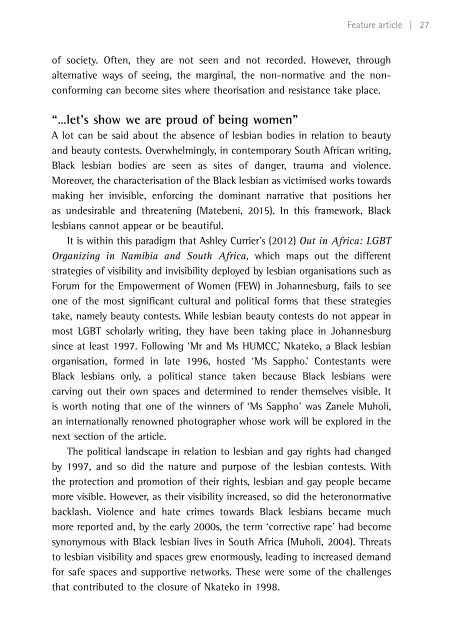The politics of fashion and beauty in Africa
fa21_proof_3
fa21_proof_3
Create successful ePaper yourself
Turn your PDF publications into a flip-book with our unique Google optimized e-Paper software.
Feature article | 27<br />
<strong>of</strong> society. Often, they are not seen <strong>and</strong> not recorded. However, through<br />
alternative ways <strong>of</strong> see<strong>in</strong>g, the marg<strong>in</strong>al, the non-normative <strong>and</strong> the nonconform<strong>in</strong>g<br />
can become sites where theorisation <strong>and</strong> resistance take place.<br />
“…let’s show we are proud <strong>of</strong> be<strong>in</strong>g women”<br />
A lot can be said about the absence <strong>of</strong> lesbian bodies <strong>in</strong> relation to <strong>beauty</strong><br />
<strong>and</strong> <strong>beauty</strong> contests. Overwhelm<strong>in</strong>gly, <strong>in</strong> contemporary South <strong>Africa</strong>n writ<strong>in</strong>g,<br />
Black lesbian bodies are seen as sites <strong>of</strong> danger, trauma <strong>and</strong> violence.<br />
Moreover, the characterisation <strong>of</strong> the Black lesbian as victimised works towards<br />
mak<strong>in</strong>g her <strong>in</strong>visible, enforc<strong>in</strong>g the dom<strong>in</strong>ant narrative that positions her<br />
as undesirable <strong>and</strong> threaten<strong>in</strong>g (Matebeni, 2015). In this framework, Black<br />
lesbians cannot appear or be beautiful.<br />
It is with<strong>in</strong> this paradigm that Ashley Currier’s (2012) Out <strong>in</strong> <strong>Africa</strong>: LGBT<br />
Organiz<strong>in</strong>g <strong>in</strong> Namibia <strong>and</strong> South <strong>Africa</strong>, which maps out the different<br />
strategies <strong>of</strong> visibility <strong>and</strong> <strong>in</strong>visibility deployed by lesbian organisations such as<br />
Forum for the Empowerment <strong>of</strong> Women (FEW) <strong>in</strong> Johannesburg, fails to see<br />
one <strong>of</strong> the most significant cultural <strong>and</strong> political forms that these strategies<br />
take, namely <strong>beauty</strong> contests. While lesbian <strong>beauty</strong> contests do not appear <strong>in</strong><br />
most LGBT scholarly writ<strong>in</strong>g, they have been tak<strong>in</strong>g place <strong>in</strong> Johannesburg<br />
s<strong>in</strong>ce at least 1997. Follow<strong>in</strong>g ‘Mr <strong>and</strong> Ms HUMCC,’ Nkateko, a Black lesbian<br />
organisation, formed <strong>in</strong> late 1996, hosted ‘Ms Sappho.’ Contestants were<br />
Black lesbians only, a political stance taken because Black lesbians were<br />
carv<strong>in</strong>g out their own spaces <strong>and</strong> determ<strong>in</strong>ed to render themselves visible. It<br />
is worth not<strong>in</strong>g that one <strong>of</strong> the w<strong>in</strong>ners <strong>of</strong> ‘Ms Sappho’ was Zanele Muholi,<br />
an <strong>in</strong>ternationally renowned photographer whose work will be explored <strong>in</strong> the<br />
next section <strong>of</strong> the article.<br />
<strong>The</strong> political l<strong>and</strong>scape <strong>in</strong> relation to lesbian <strong>and</strong> gay rights had changed<br />
by 1997, <strong>and</strong> so did the nature <strong>and</strong> purpose <strong>of</strong> the lesbian contests. With<br />
the protection <strong>and</strong> promotion <strong>of</strong> their rights, lesbian <strong>and</strong> gay people became<br />
more visible. However, as their visibility <strong>in</strong>creased, so did the heteronormative<br />
backlash. Violence <strong>and</strong> hate crimes towards Black lesbians became much<br />
more reported <strong>and</strong>, by the early 2000s, the term ‘corrective rape’ had become<br />
synonymous with Black lesbian lives <strong>in</strong> South <strong>Africa</strong> (Muholi, 2004). Threats<br />
to lesbian visibility <strong>and</strong> spaces grew enormously, lead<strong>in</strong>g to <strong>in</strong>creased dem<strong>and</strong><br />
for safe spaces <strong>and</strong> supportive networks. <strong>The</strong>se were some <strong>of</strong> the challenges<br />
that contributed to the closure <strong>of</strong> Nkateko <strong>in</strong> 1998.



